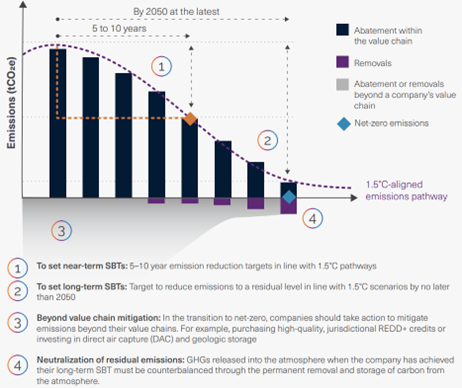Definitions
- GHG: Greenhouse gases commonly referred as GHGs as covered by the Kyoto Protocol include – carbon dioxide (CO2), methane (CH4), nitrous oxide (N2O), hydrofluorocarbons (HFCs), perfluorocarbons (PCFs), sulphur hexafluoride (SF6) and nitrogen trifluoride (NF3)
- Carbon footprint: It is the total GHG emissions caused by a firm, individual, event, service, product or geography, expressed as carbon dioxide equivalent (CO2e)
- Scope 1, 2 and 3 emission boundaries: The GHG Protocol Corporate Standard classifies a company’s GHG emissions into three ‘scopes’. Scope 1 emissions are direct emissions from owned or controlled sources. Scope 2 emissions are indirect emissions from the generation of purchased energy. Scope 3 emissions are all indirect emissions (not included in scope 2) that occur in the value chain of the reporting company, including both upstream and downstream emissions.
- SBTi: The Science Based Targets initiative (SBTi) is a partnership between CDP, the United Nations Global Compact, World Resources Institute (WRI) and the World Wide Fund for Nature (WWF) to drive ambitious climate action in the private sector by enabling firms to set science-based emissions reduction targets. Read more on org/
- Net Zero: Adopting net zero definition as published by SBTi in Net Zero Standard.
For firms, net zero means a) reducing their scope 1, 2 and 3 emissions to zero or to a residual level that is consistent with reaching net-zero emissions at the global or sector level in eligible 1.5°C scenarios or sector pathways and (b) neutralising any residual emissions at the net-zero target date and any GHG emissions released into the atmosphere thereafter.
How to approach carbon management?
A first step towards carbon management is understanding the firm’s carbon footprint during the identified timeframe (baseline) at a parent company or a group level, across each emission boundary. You may use freely available Net Zero Insurance Alliance (NZIA) Target setting protocol which adheres to the SBTi criterion for baseline calculation, target setting and provides guidance on disclosure of the firm’s carbon management. NZIA protocol enables insurance sector firms set science-based, intermediate targets for their respective insurance and reinsurance underwriting portfolios in line with a net-zero transition pathway consistent with a maximum temperature rise of 1.5°C.
Key considerations
- Select a year (previous or current) no earlier than 2019 for a baseline calculation across scope 1, scope 2 and/or scope 3 emissions boundaries
- Take stock of data required for calculating emissions, mainly fuel consumption (from vehicles owned by the member, business travel for scope 3), energy consumption (electricity and gas) and utilities data (f-gas used in refrigeration, air conditioners, etc).
- Fuel data can be natural gas, petrol/diesel or liquefied petroleum gas (LPG). You may find this information in bills, fuel card data or meter reading records
- For Fluorinated-gases (F-gases), members can find this information in the service sheets provided by the utility maintenance contractor
- Calculate emissions using freely available carbon footprint calculators like those below, or by taking assistance from third party consultants using known methodologies like ISO 14064 or PAS 2050
- Carbon Trust’s carbon footprint calculator for SMEs
- Carbon Footprint Ltd’s free carbon calculator
- Use NZIA protocol which references SBTi Corporate Net-Zero Standard to define four key elements for net-zero target setting
Note: image is taken from the SBTi corporate net zero standard

- Action plan to achieve targets can be a mix of reduction and offsetting/neutralisation
- Emissions reduction strategies may include focus on –
- Energy efficiency at workplaces
- Switch to low/zero-emission power and fuel (public transport, electric vehicles use, etc)
- Use of ICT technologies like Zoom and MS Teams, travel only when necessary
- Circular economy and zero-waste to landfills: switch to vendors who can support you move to zero waste to landfill and re-use/recycle waste generated
- Offset/neutralisation action plan may include selection of projects from reputed platforms like below. This article from Marsh provides an insight into evolving carbon offset market. It is recommended to purchase offset credits digitally from the reputed platforms such as below:
- UN’s clean development mechanism (CDM): you can choose offset credits from a range of projects in renewable energy, neutralisation, afforestation or reforestation, etc: climateneutralnow.org/AllProjects
- Projects from the gold standard: goldstandard.org/collections/projects
- Verra carbon credits: org/programs/verified-carbon-standard/
- Emissions reduction strategies may include focus on –
Key Performance Indicators (KPIs) to adopt
- Baseline emissions recording
| Baseline year | Scope 1 emissions | Scope 2 emissions | Scope 3 emissions | Total emissions |
| 20xx | X tCO2e | X tCO2e | X tCO2e |
- Baseline emissions intensity: defined as total emissions per £ revenue/sales for the baseline year
- Current year emissions
| Year | Scope 1 emissions | Scope 2 emissions | Scope 3 emissions | Total emissions |
| 202x | X tCO2e | X tCO2e | X tCO2e | |
| % Reduction over baseline | ||||
| % Reduction achieved through carbon offsetting |
- Current year emissions intensity: defined as total emissions per £ revenue/sales for the financial year
The Government’s policies and incentives to watch out for
- To support net zero projects for firms, Crown Commercial Services (CCS) have collated a list of open carbon net zero grants, eligibility criterion and funding opportunities from across the Government into a single place. crowncommercial.gov.uk/buy-and-supply/carbon-net-zero/carbon-net-zero-funding-and-grants/
- Carbon Reduction policy: gov.uk/government/publications/carbon-reduction-policy
Further reading and reference
- SBTi’s guidance on Net zero for beginners org/resources/files/foundations-for-net-zero-full-paper.pdf
- The UK Government’s Net Zero Strategy: Build Back Greener. This strategy sets out policies and proposals for decarbonising all sectors of the UK economy to meet our net zero target by 2050. gov.uk/government/publications/net-zero-strategy
- Guidance to write Carbon Reduction Plan(CRP): publishing.service.gov.uk/government/uploads/system/uploads/attachment_data/file/991625/PPN_0621_Technical_standard_for_the_Completion_of_Carbon_Reduction_Plans__2_.pdf
- Carbon Reduction Plan(CRP) template: publishing.service.gov.uk/government/uploads/system/uploads/attachment_data/file/1053009/PPN-0621-Carbon-Reduction-Plan-Template-Jan22.odt
